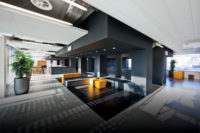Healthcare facilities serve a diverse blend of occupants including frontline workers, patients, visitors, researchers and students in teaching hospitals. In the case of telemedicine, a healthcare facility may serve people beyond the immediate environment.
Across all of these settings, introducing design strategies to manage sound can support both patients and practitioners with more comfortable, better performing acoustic spaces. Below, we review some strategies for supporting acoustics in the design stage, and also offer thoughts on mitigating noise in existing spaces.
Let’s begin by defining “noise” as “unwanted sound” and considering the challenges it presents in the healthcare environment. Three common sources of noise in the healthcare space include crossover noise between patient rooms, HVAC noise, and reverberation. The consequences of noise can range from communication issues to disturbed sleep to breaches in privacy to work errors. And at a time when outcome-based care is linking hospitals’ financial compensation to patient evaluations, noise in the healthcare space may even inflict economic pain.
Trends in healthcare facility design are making noise control more challenging. For example, hospitals’ efforts to lower the number of hospital-acquired infection (HAI)-related microorganisms by limiting soft surfaces such as drapes, carpet and other textiles, creates spaces where sound is more likely to reverberate off tile, hardwood, steel and other hard, bacteria-resistant surfaces and reflect back into the spaces or spill over into hallways or to other spaces.
As good design is less disruptive and more economical than retrofitting to resolve a problem, the ideal time to preempt noise problems is in the design phase. Below we look at four strategies for avoiding noise in the healthcare space:
Guidelines for Supporting Sound Design
Consider the purpose of a space: What kind of activities and conversation will be taking place? Will the area demand high levels of privacy, clear and precise communication, or require technology such as the digital devices often used in telemedicine? Something as simple as isolating areas with heavier traffic and activity away from consulting areas can protect privacy, and limit background noise while achieving a more acoustically comfortable space. Another design solution is specifying outlets on either side of the wall do not share the same cavity which reduces the opportunity for sound to move between adjacent spaces.
Specify cost-effective materials: Selecting acoustic materials in the design phase results in an economical approach to noise control that is easy to implement during construction. For example, solid core doors equipped with drop down door seals are a cost-effective way to address flanking noise. Lining ducts that feed adjacent spaces reduces both the reverberant sound within the space and limits sound from traveling between spaces. Caulking the perimeter of walls can also reduce noise transmission between rooms with minimal cost. Adding insulation to a telemedicine space will reduce reverberation and create clearer speech for both the listener and the speaker.
Specify full-height walls: Specifying walls that go up to the ceiling deck is the best defense against flanking noise traveling from room to room via ceiling plenums. If a full-height wall partition is not practical, adding a row of insulation 6 inches thick and 24 inches wide along each wall’s perimeter above the ceiling will lower the level of flanking noise. Installing caulking on the perimeter and crown molding at the intersection of the wall and ceiling will also reduce transmitted sound enhancing speech privacy.
Don’t overlook mechanical noise: When steam and various mechanical systems cycle through various phases, noise levels can infiltrate other areas. Adding fibrous pipe insulation, isolating pipes from the building structure, and running pipes away from areas that pose additional sound challenges – for example a telemedicine room - can avoid problems with mechanical noise interference. Adding insulation within the wall assembly of the mechanical room and surrounding areas can also keep mechanical noise from infiltrating other spaces. Additionally, adding insulation on the walls and/or ceiling of the mechanical room reduces the sound within the space allowing less sound to travel out of the space.
Managing Noise in the Healthcare Enclosure
Of course, not every facility can be constructed anew. Four strategies for managing noise—whether it comes from rooftop HVAC systems, hallways, or the patient room next door—are discussed below:
Absorbing noise: Absorptive approaches to managing noise focus on capturing and dissipating sound before it reverberates off hard surfaces. Adding insulation above a suspended ceiling’s tiles, installing decorative wall panels or adding acoustic blankets behind walls are some absorptive approaches to reduce noise.
Blocking noise: Creating solid barriers to the transmission of sound between spaces is the blocking approach. Selecting solid core doors with drop down seals, and good wall designs is important. For a good wall design, insulation added to the wall cavity helps reduce sound energy as it transmits through the wall assembly, improving performance significantly. A common question is whether mineral wool or fiberglass provides a more effective insulating material. For non-high-performing walls (STC < 50), there is no significant acoustic performance benefit between the two insulations. Considering a material’s other desired performance properties is a better means of evaluating various insulating options while also managing noise.
For example, as mineral wool and unfaced fiberglass are non-combustible, these materials are well suited to environments where occupants might not be ambulatory and able to egress a building quickly in the event of a fire. Other properties such as a material’s ability to manage moisture (both vapor and liquid) or contribute to various sustainability certifications may also influence the choice of insulating material. The Sidney & Lois Eskenazi Hospital in Indianapolis, one of the nation’s largest LEED Gold healthcare facilities, uses Thermafiber RainBarrier insulation to help manage liquid and vapor moisture as part of a continuous insulation strategy in the building’s exterior assembly. While in this case the focus of the ci supports thermal performance and moisture management, mineral wool insulation also delivers impressive acoustic performance.
Breaking noise paths: The breaking noise strategy inhibits noise from transmitting through a wall by disrupting the channels that carry sound. Components within a wall—such as studs—can serve as conduits to carry a noise through the wall and into another space.
An example of a breaking noise paths is a double wall construction. Instead of the drywall on either side sharing studs, each drywall has its own studs, breaking the path of the energy to transmit through the studs causing more energy to be directed into the wall cavity. Insulation in the cavity between double walls significantly reduces the energy flowing from one space into another.
Isolating noise: Isolating strategies help reduce mechanical vibration and structural transmission of sound energy by relying on a soft connection between system components. Resilient channels are one isolation approach that reduces the transfer of sound energy-induced vibration into wall studs from the drywall coverings and through ceiling joists to ceiling drywall covering. The channels support a structural connection between the covering and the stud/joist but impede vibration from being conducted through the assembly. Combining resilient channels with sound absorption techniques can dramatically improve the management of sound energy between spaces. Vibration insulators integrated into mounting of rooftop cooling units can keep HVAC system vibration from transmitting into the building structure and radiating into spaces below. Also acoustic floormats installed under the subfloor provide some improvement in airborne sound transmission loss and a sizeable improvement in impact isolation.
Advancing Innovations to Support Acoustic Performance
The Owens Corning Acoustic Research Center continually evaluates assemblies to identify factors that influence sound performance in healthcare and other commercial/institutional buildings. The center provides acoustic services to a spectrum of third-party industry groups. Discoveries at the Acoustic Research Center are fueling additional innovations to support acoustic performance.
Of course, even the most advanced insulation and innovative assembly will not deliver its acoustic potential if it is improperly installed. A range of resources available through the National Insulation Association can support architects and contractors in properly installing insulation. Owens Corning provides technical bulletins addressing acoustics in various assemblies and environments.
The link between the healthcare environment and patient outcomes continues to be an area of study. By taking a prescriptive approach to insulation at the outset, designers can create more acoustically comfortable facilities for all stakeholders served.








Report Abusive Comment